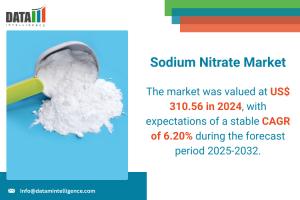Sodium Nitrate Market Set for Stable Growth Amid Rising Demand Across Industrial Sectors | DataM Intelligence
Sodium nitrate market is driven by rising demand in agriculture, food processing, and industrial sectors, with a stable CAGR of 6.20% through 2032.
Market Overview:
Demand Driven by Agriculture, Industrial Manufacturing
Sodium nitrate (NaNO₃) is an inorganic compound widely utilized for its oxidizing properties. Commonly found as a white crystalline solid, it serves as a critical raw material in fertilizers, explosives, and food preservatives. Its high solubility and stability make it a valuable input in agriculture, pyrotechnics, heat storage systems, and even pharmaceutical formulations.
The global sodium nitrate market was valued at approximately US$ 310.56 in 2024, with expectations of a stable CAGR of 6.20% during the forecast period 2025-2032.
The sodium nitrate market is experiencing steady growth driven by its diverse industrial and agricultural applications. With the rising population, rapid urbanization, and changing dietary preferences, global food demand is increasing significantly. According to the Food and Agriculture Organization (FAO), feeding a global population of 9.1 billion by 2050 will require a 70% increase in overall food production from 2005/07 levels, with nearly a 100% increase needed in developing countries. This surge in food production is driving the demand for fertilizers, where sodium nitrate plays a key role in enhancing crop yields and soil fertility.
Get Detailed Sample PDF: https://www.datamintelligence.com/download-sample/sodium-nitrate-market
The expanding industrial applications of sodium nitrate, particularly in the explosives and glass manufacturing sectors, are playing a pivotal role in driving market growth. In the explosives industry, sodium nitrate serves as a vital oxidizing agent in the production of industrial explosives used extensively in mining, construction, and defense. The ongoing global infrastructure development and the surge in mining activities, especially in emerging economies, are significantly increasing the demand for such explosives, thereby accelerating sodium nitrate consumption.
Challenges, Opportunities, Supply Chain, Regulation, and Innovation
Sodium nitrate faces significant supply chain challenges due to its reliance on mining and natural deposits, which are geographically limited and subject to geopolitical risks. Transportation and storage require careful handling because of their oxidizing properties, increasing logistical complexity and costs. Regulatory scrutiny is rising globally, as sodium nitrate is classified under hazardous materials, demanding strict compliance with safety and environmental laws. Regulatory bodies like the EPA (Environmental Protection Agency) in the US and the EU REACH framework impose strict controls on sodium nitrate’s production, storage, and usage to minimize environmental and health impacts. These regulatory pressures push companies to innovate greener alternatives and safer handling processes.
Innovations from companies such as Yara International in synthetic nitrate production reduce reliance on natural deposits, improving supply stability. Digital tools like blockchain are increasingly adopted to enhance traceability across the supply chain, reducing fraud and delays. Growing demand in agriculture, food preservation, and industrial explosives creates new market opportunities for sodium nitrate suppliers. Sustainable practices by leaders like CF Industries allow them to meet regulations while boosting brand reputation.
Asia-Pacific Leads Driven by Rapid Industrialization and Agricultural Expansion
Rising demand for sodium nitrate as a key component in fertilizers to enhance crop yields is a primary driver, supported by the region's large agricultural base. Government initiatives promoting agricultural productivity and infrastructure development further stimulate market growth. For instance, the Government of India has substantially boosted its agricultural budget from US$ 1390.71 million (₹11,915.22 crore) in 2008-09 to US$ 1,430.122 billion (₹1,22,528.77 crore) in 2024-25, reflecting a strong commitment to the sector. This enhanced funding supports greater fertilizer subsidies and adoption, including sodium nitrate-based fertilizers, which are vital for improving soil nutrient levels and crop yields. Increased investment in agriculture infrastructure and productivity encourages higher usage of sodium nitrate as a key input, boosting demand.
Additionally, the booming manufacturing industries in countries like China, India, and Japan fuel the demand for sodium nitrate in explosives, glass production, and food preservation applications. China leads the Asia-Pacific sodium nitrate market, followed by Japan and South Korea, with India demonstrating strong growth potential. Additionally, ASEAN countries—especially Malaysia, Thailand, and Indonesia—are experiencing significant investments in construction glass and infrastructure development, further driving regional demand for sodium nitrate. The rapid urbanization and infrastructure development across the region have spurred construction activities, further propelling the demand for high-quality glass products used in windows, automotive, electronics, and packaging industries. This industrial growth directly correlates with increased sodium nitrate consumption, as manufacturers rely on it to optimize production processes.
Key Market Players:
Major market participants include BASF SE, Sumitomo Chemical Co., Ltd., Merck KGaA, SQM (Sociedad Química y Minera de Chile), and Shandong Haihua Group. These companies are investing in production capacity expansions, mergers, and R&D to develop high-purity sodium nitrate variants.
For detailed insights, market segmentation, and competitive benchmarking, access the full Sodium Nitrate Market report here: https://www.datamintelligence.com/buy-now-page?report=sodium-nitrate-market
Related Reports:
Sodium Chlorite Market Size 2024-2031
Sodium Cyanide Market Size 2024-2031
Sai Kiran
DataM Intelligence 4market Research LLP
+1 877-441-4866
sai.k@datamintelligence.com
Visit us on social media:
LinkedIn
X
Legal Disclaimer:
EIN Presswire provides this news content "as is" without warranty of any kind. We do not accept any responsibility or liability for the accuracy, content, images, videos, licenses, completeness, legality, or reliability of the information contained in this article. If you have any complaints or copyright issues related to this article, kindly contact the author above.
ACP Painting, LLC Featured on Rosie On The House Podcast: A Deep Dive Into Arizona House Painting
Premium 73‑Acre Off‑Grid Luxury Barndominium Estate Listed Near Richards, Texas
Insurance School of TampaBay (ISOTB) now offers tutoring to non-ISOTB students
Kalendarium
Więcej ważnych informacji
 Jedynka Newserii
Jedynka Newserii

 Jedynka Newserii
Jedynka Newserii

Prawo

Trwają dyskusje nad kształtem unijnego budżetu na lata 2028–2034. Mogą być rozbieżności w kwestii Funduszu Spójności czy dopłat dla rolników
Trwają prace nad wieloletnimi unijnymi ramami finansowymi (WRF), które określą priorytety wydatków UE na lata 2028–2034. W maju Parlament Europejski przegłosował rezolucję w sprawie swojego stanowiska w tej sprawie. Postulaty europarlamentarzystów mają zostać uwzględnione we wniosku Komisji Europejskiej w sprawie WRF, który zostanie opublikowany w lipcu 2025 roku. Wciąż jednak nie ma zgody miedzy państwami członkowskimi, m.in. w zakresie Funduszu Spójności czy budżetu na rolnictwo.
Konsument
35 proc. gospodarstw domowych nie stać na zakup mieszkania nawet na kredyt. Pomóc może wsparcie budownictwa społecznego i uwolnienie gruntów pod zabudowę

W Polsce co roku oddaje się do użytku ok. 200 tys. mieszkań, co oznacza, że w ciągu dekady teoretycznie potrzeby mieszkaniowe społeczeństwa mogłyby zostać zaspokojone. Jednak większość lokali budują deweloperzy na sprzedaż, a 35 proc. gospodarstw domowych nie stać na zakup nawet za pomocą kredytu. Jednocześnie ta grupa zarabia za dużo, by korzystać z mieszkania socjalnego i komunalnego. Zdaniem prof. Bartłomieja Marony z UEK zmniejszeniu skali problemu zaradzić może wyłącznie większa skala budownictwa społecznego zamiast wspierania kolejnymi programami zaciągania kredytów.
Problemy społeczne
Hejt w sieci dotyka coraz więcej dzieci w wieku szkolnym. Rzadko mówią o tym dorosłym

Coraz większa grupa dzieci zaczyna korzystać z internetu już w wieku siedmiu–ośmiu lat – wynika z raportu NASK „Nastolatki 3.0”. Wtedy też stykają się po raz pierwszy z hejtem, którego jest coraz więcej w mediach społecznościowych. Według raportu NASK ponad 2/3 młodych internautów uważa, że mowa nienawiści jest największym problemem w sieci. Co więcej, dzieci rzadko mówią o takich incydentach dorosłym, dlatego tym istotniejsze są narzędzia technologiczne służące ochronie najmłodszych.
Partner serwisu
Szkolenia

Akademia Newserii
Akademia Newserii to projekt, w ramach którego najlepsi polscy dziennikarze biznesowi, giełdowi oraz lifestylowi, a także szkoleniowcy z wieloletnim doświadczeniem dzielą się swoją wiedzą nt. pracy z mediami.








.gif)

 |
| |
| |
|